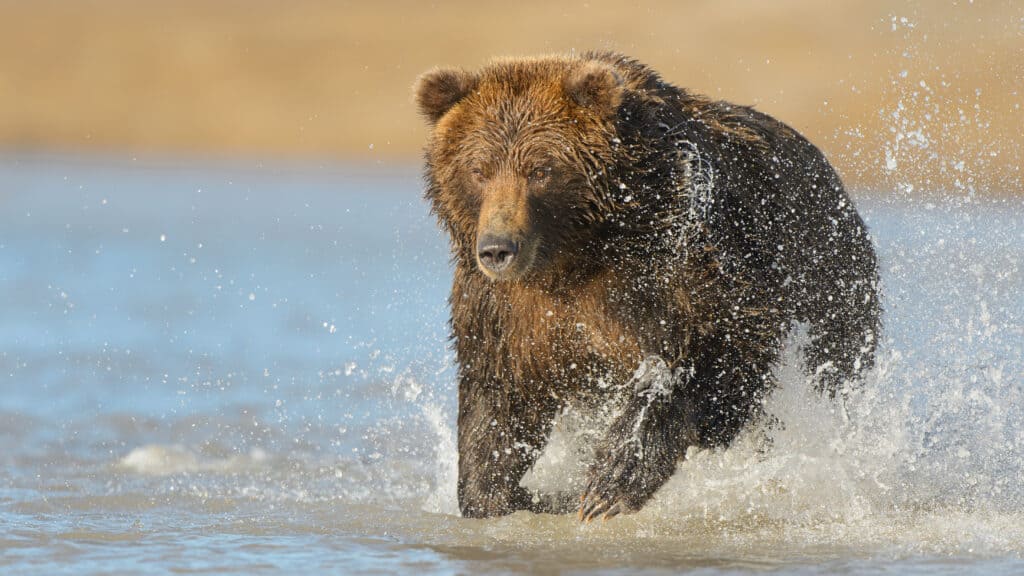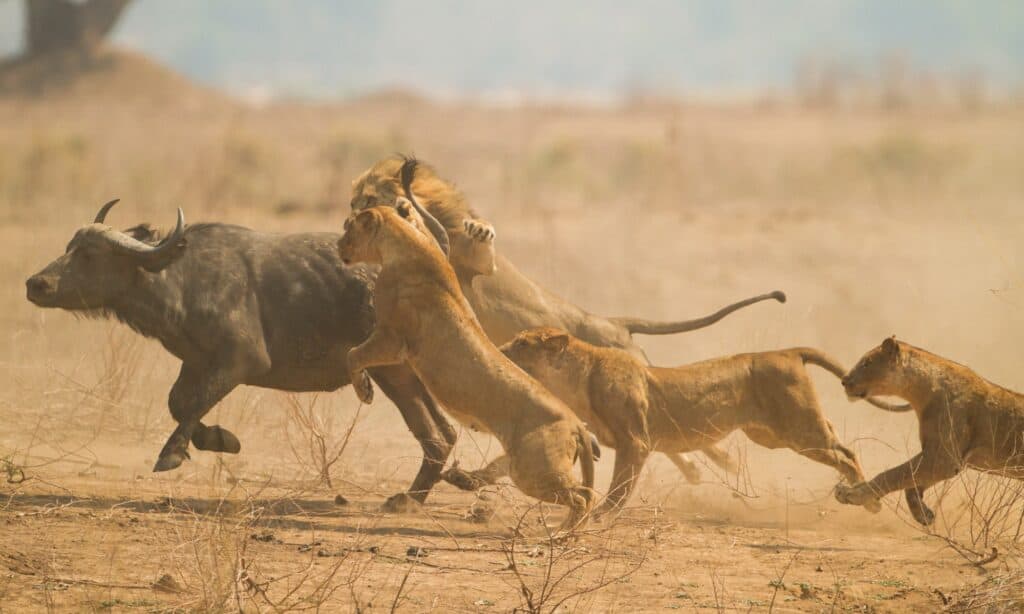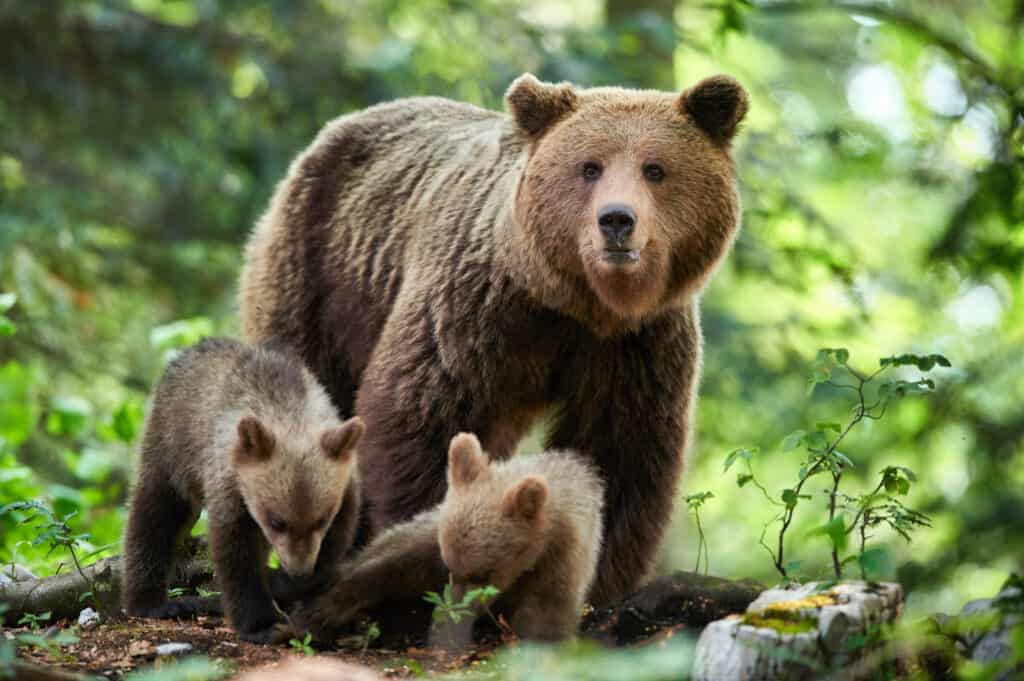Grizzly bears are some of the largest, most powerful mammals in the world. However, their modern range isn’t conducive to a meeting with lions, the big cats native to Africa. If they did meet and had a reason to fight, perhaps over a fresh antelope kill, how would the fight play out? Today, we’re going to imagine what would happen in a grizzly bear vs. lion fight.
We’ll break down this fight in several ways, showing you which of these animals has the superior speed, size, power, and instincts to bring down the opposing creature. See what happens in this epic battle between deadly apex predators!
Comparing Grizzly Bear vs. Lion
| Grizzly Bear | Lion | |
|---|---|---|
| Size | Weight: 400lbs-700lbs Length: 7 ft-10 ft Height: 3 ft-4.5 ft at the shoulder | Weight: 260 lbs – 550 lbs Length: 4.7 ft-8.2 ft Height: 3 ft-3.9 ft |
| Speed and Movement Type | – 35 mph on land – Roughly 6 mph in the water | – 35 mph – Can run up to 40-50 mph when closing on foes |
| Defenses | – Thick skin – Large size – Stands on hind legs for threat display – Uses bluff charges to scare away foes | – Stays with pride for safety in numbers – Relatively large size as a carnivore frightens away many enemies – Can quickly run away from enemies |
| Offensive Capabilities | – 975 PSI bite – 42 teeth that measure about 1 inch in length – Strong bites, vicious shaking attacks – 4-inch claws – Powerful swipe attacks with its massive paws – They maul their prey with deadly bites that break bones | – Sharp, 1.5-inch claws can gash foes wide open – Paw strikes can deliver a powerful, staggering blow – Strong biting power of 650 PSI- 1,000 PSI can splinter bones and tear prey open – Use their powerful bites to suffocate prey or break their necks |
| Predatory Behavior | – Grizzly bears are opportunistic predators that surprise their prey when they spot it – They are also scavengers | – Endurance predator or ambush predator – Works as a group to take down prey |
The 5 Key Differences Between Grizzly Bears and Lions

Weighing around 700 pounds, grizzly bears are much larger and heavier than lions.
© NaturesMomentsuk/Shutterstock.com
The most significant differences between a grizzly bear and a lion can be found in their overall size and methods of predation. Grizzly bears are larger than lions, weighing up to 700 pounds while lions weigh about 550 pounds. Meanwhile, grizzlies can grow up to 10 feet long and stand 4.5 feet at the shoulder while lions stand about 3 to 3.9 feet tall and grow 8.2 feet long including their tails.
Also, lions are predators that use an ambush or endurance predation style to bring down their prey while grizzly bears are opportunistic predators that use elements of an ambush to suddenly overwhelm their prey.
These differences in size and attack style are significant, and they will play a major role in determining which of these creatures is most likely to win the fight against the other.
What Are the Key Factors in a Fight Between a Grizzly Bear and a Lion?
When two large, deadly predators fight one another, certain factors become more important than others. In the case of a grizzly bear vs. lion, the key factors in the battle are going to be size, offensive capabilities, defenses, and predatory behavior.
We’ll examine each of these characteristics along with others to give you a full picture of which animal has the greatest advantages in a fight against the other.
Grizzly Bear vs. Lion: Size
Grizzly bears are larger than lions both on average and at their maximum sizes. Although grizzly bears weigh between 400 and 700 pounds on average, but they have the potential to weigh more. They grow between 7 and 10 feet and stand between 4 and 4.5 feet at the shoulder.
Meanwhile, lions weigh between 260 and 550 pounds, grow between 4.7 and 8.2 feet long, and stand between 3 and 3.9 feet tall. It’s clear in this case that grizzly bears, even standing on all four paws, are much larger.
Grizzly bears have a size advantage over lions.
Grizzly Bear vs. Lion: Speed and Movement
A grizzly bear that is running at full speed can reach about 35 mph, a fact that should frighten any animal or human that wanders into its territory.
While a lion can run at 35 mph for medium distances, its closing speed on prey is even higher, somewhere between 40 and 50 mph. However, that is a speed reserved for very short distances to give them enough speed to grab and bring down their prey.
Lions have the potential to reach greater speeds than grizzly bears on flat ground.
Grizzly Bear vs. Lion: Defenses
The main defense used by lions is grouping up with other lions into collectives called prides. The presence of several adult lions will frighten off most other large predators. However, lions are also large creatures that are too powerful for most animals in their range to attack. Also, if a lion finds itself in a predicament, it could use its speed to escape. Male lions along with some females also have a mane around their neck to protect against bites.
Grizzly bears have thick skin, abundant thick fur, and large sizes to frighten off would-be attackers. They are apex predators, so it’s rare for them to fall victim to predation as adults. Although they tend to live solitary lives, grizzlies may gather together at times. Otherwise, they use their natural defenses along with their defensive posturing, rearing back to increase their size or bluff charging, to frighten off potential enemies.
Grizzly bears have better defenses than lions, but only as far as individuals are concerned.
Grizzly Bear vs. Lion: Offensive Capabilities
Both grizzly bears and lions are both powerful creatures that rely on a combination of their powerful jaws, teeth, and claws to kill their prey. Grizzly bears can bite with a force of 975 PSI, and lions can bite somewhere between 650 PSI and 1,000 PSI, though the latter measure is still up for debate.
Grizzly bears have four-inch-long claws, and lions have 1.5-inch-long claws. While lions use theirs to dig in on their prey or to deliver a powerful paw swipe, they are not as powerful or dangerous as a grizzly bear doing the same thing. A grizzly bear’s paw swipe with its claws can tear open its prey or render them unconscious.
Lions deliver powerful bites to the neck of their prey to suffocate them or render them unable to fight back by breaking the bones in the neck. Grizzly bears are more ferocious in that they maul their prey, tackling, biting, and clawing in a flurry to kill and eat their prey while fighting. The end result is usually a fatal bite to the neck, back, or head.
Grizzly bears have more powerful offensive capabilities than lions.
Grizzly Bear vs. Lion: Predatory Behavior

Lions live in prides and often work together to bring down their prey.
©iStock.com/jez_bennett
Lions are known for hunting in prides as well as hunting alone, using either ambush tactics or endurance predation to wear down their prey. They are very effective hunters.
Grizzly bears are opportunistic predators that use elements of ambushes when they spot prey. They are also scavengers that will eat fruits, vegetables, and even human leftovers.
In this situation, lions have a definitive advantage because they are coordinated and powerful hunters with a diet primarily consisting of meat. Yet, their skill as individual hunters may not be enough to give them an advantage over grizzly bears.
Lions have more powerful, nuanced predatory behaviors against their prey than grizzly bears.
Who Would Win in a Fight Between a Grizzly Bear and a Lion?
A grizzly bear would win a fight against a lion, probably with a grizzly bear breaking the lion’s back or biting through its skull. The lion indeed has an advantage in terms of their skill in hunting, especially if they are attacking in a pack.
However, in a one-on-one fight, the grizzly bear has many advantages. For example, the grizzly bear has a significant size advantage because it weighs more, grows longer, and stands taller than the lion. Also, a lion cannot match a grizzly for raw power.
While a lion is stuck fighting on all fours, the grizzly bear can rear back onto its hind legs, essentially allowing it to climb on top of its foe. This technique is regularly employed by grizzly bears attacking deer.
The lion is swifter and more agile, but it’s not too quick and agile to avoid every attack from a grizzly. The multifaceted grizzly would maul the lion with bites, clawings, and paw smacks that would severely injure the smaller creature. If the grizzly managed to get on top of a lion and use its weight in the fight, then the bear would bite the lion’s back, breaking its vertebrae, and then finish it off with a skull-crushing bite.
What Animal Could Defeat a Grizzly Bear?

An
elephant
could easily defeat a grizzly bear.
©JohnEGoodwin/Shutterstock.com
Being able to take down the mighty lion in combat is quite an impressive feat, but there are many other creatures in the animal kingdom that a grizzly bear simply could not defeat. The African elephant is one such opponent. While these creatures, like the lion, live on a completely different continent than grizzlies and therefore would never naturally have reason to go to battle, the outcome can easily be predicted by examining each creature’s respective traits.
While grizzly bears may possess impressive amounts of power in their razor-sharp teeth and claws, the lacerations inflicted by the bear would be futile against the elephant’s rough, thick skin. In the end, the elephant’s massive size in relation to the grizzly would be the bear’s demise, as the elephant can do utterly devastating damage by trampling when worked into a frenzy, and the bear is simply not equipped with natural defenses capable of withstanding the force of the stomps.
Bonus: Which Animal Kills More Humans: Lions or Bears?

Most bear attacks are by mothers defending their cubs.
©Piotr Krzeslak/Shutterstock.com
After contemplating the fighting power of two apex predators – grizzlies and lions – you may wonder which of these animals is responsible for the most human fatalities. Scientists recently documented 5,440 attacks recorded from 1950 – 2019 – from 12 different species of big cats, canids (wolves and coyotes), and bears. One in three of those total attacks proved to be fatal. The study showed that large carnivore attacks are increasing in number, especially in lower-income countries where people and predators live in closer proximity.
The big cats were responsible for the deadliest attacks, with 65% being fatal compared to 49% for canids and 9% for bears. One important difference to note is that big cats and canids sometimes stalk and attack humans as prey – while the bears more often react to being taken by surprise. Bear attacks occurred when they were either disturbed while feeding or when a mother reacted to protect her cubs.
The photo featured at the top of this post is © SeymsBrugger/Shutterstock.com
Sources
- US Fish & Wildlife Service, Available here: https://www.fws.gov/species/grizzly-bear-ursus-arctos-horribilis
- University of Montana, Available here: https://www.cfc.umt.edu/grizzlybearrecovery/grizzly-bears/biology.php#:~:text=Grizzly%20bears%20are%20opportunistic%20omnivores,fungi%2C%20nuts%2C%20and%20ungulates.
- Science Direct, Available here: https://www.sciencedirect.com/science/article/abs/pii/S0003347298908843
Thank you for reading! Have some feedback for us? Contact the AZ Animals editorial team.






